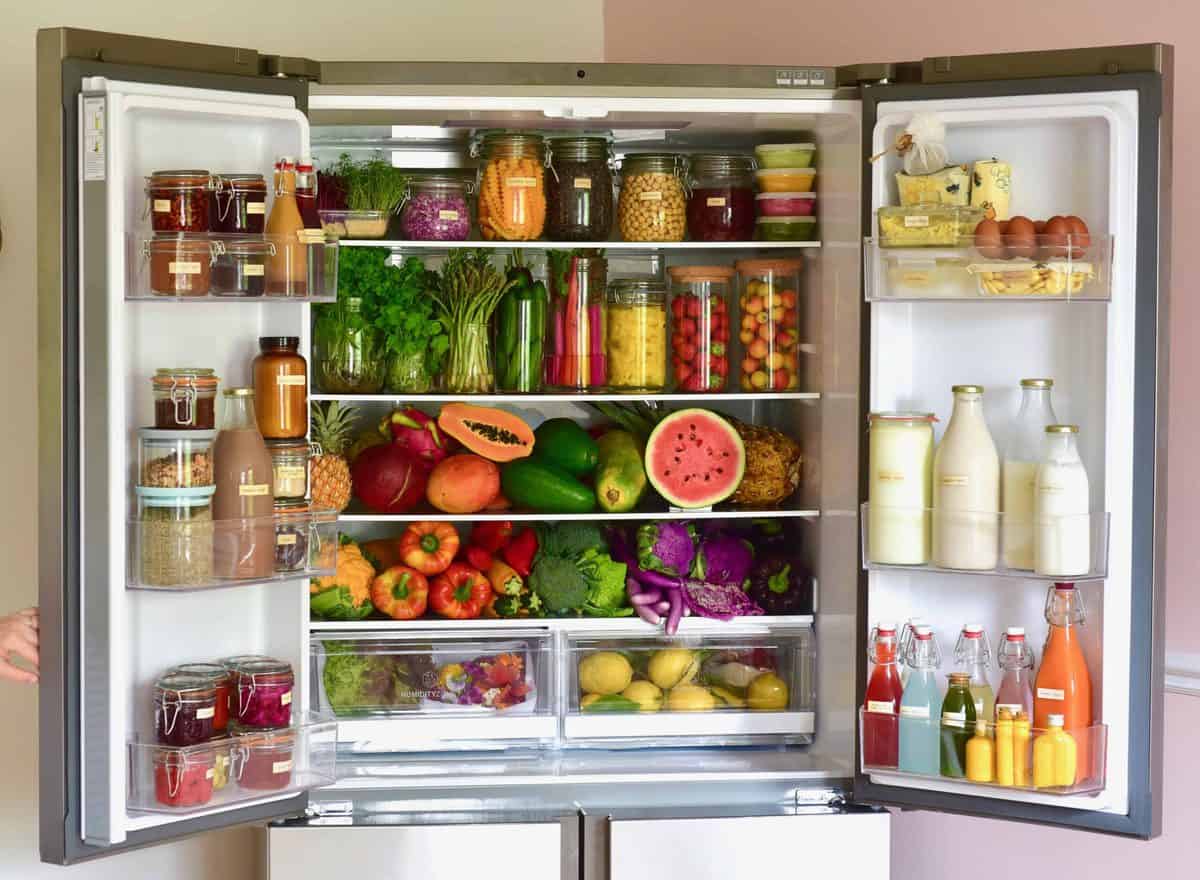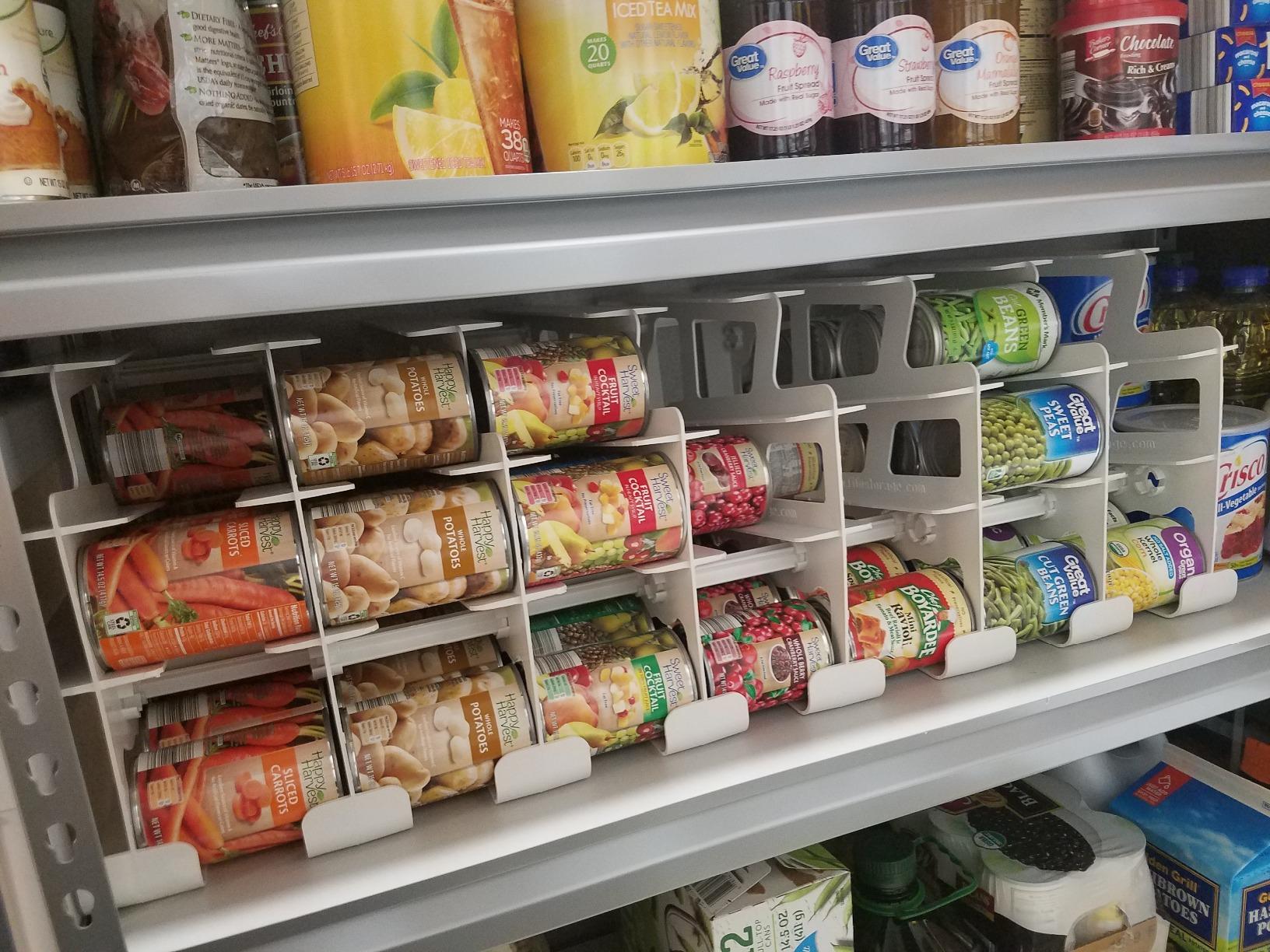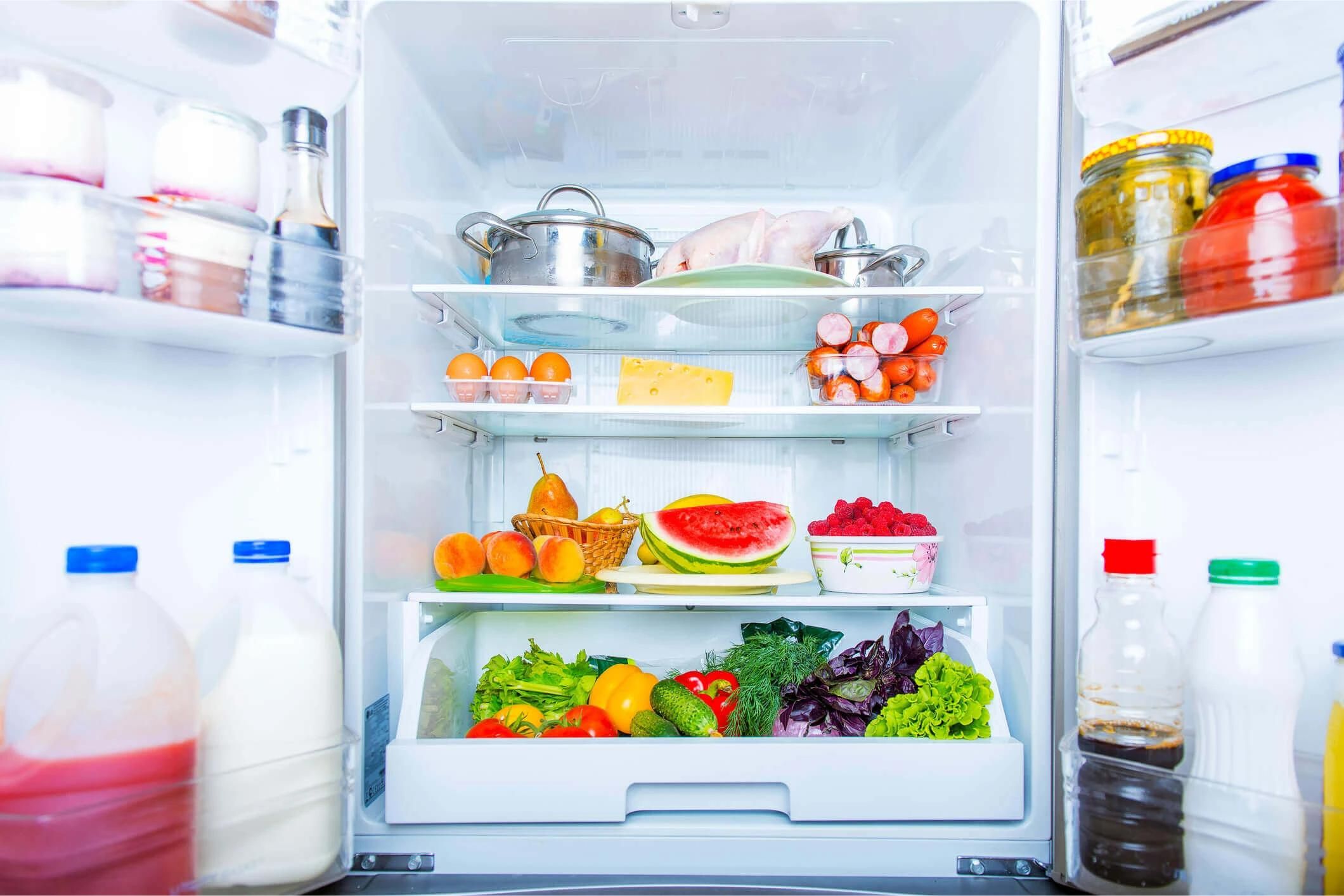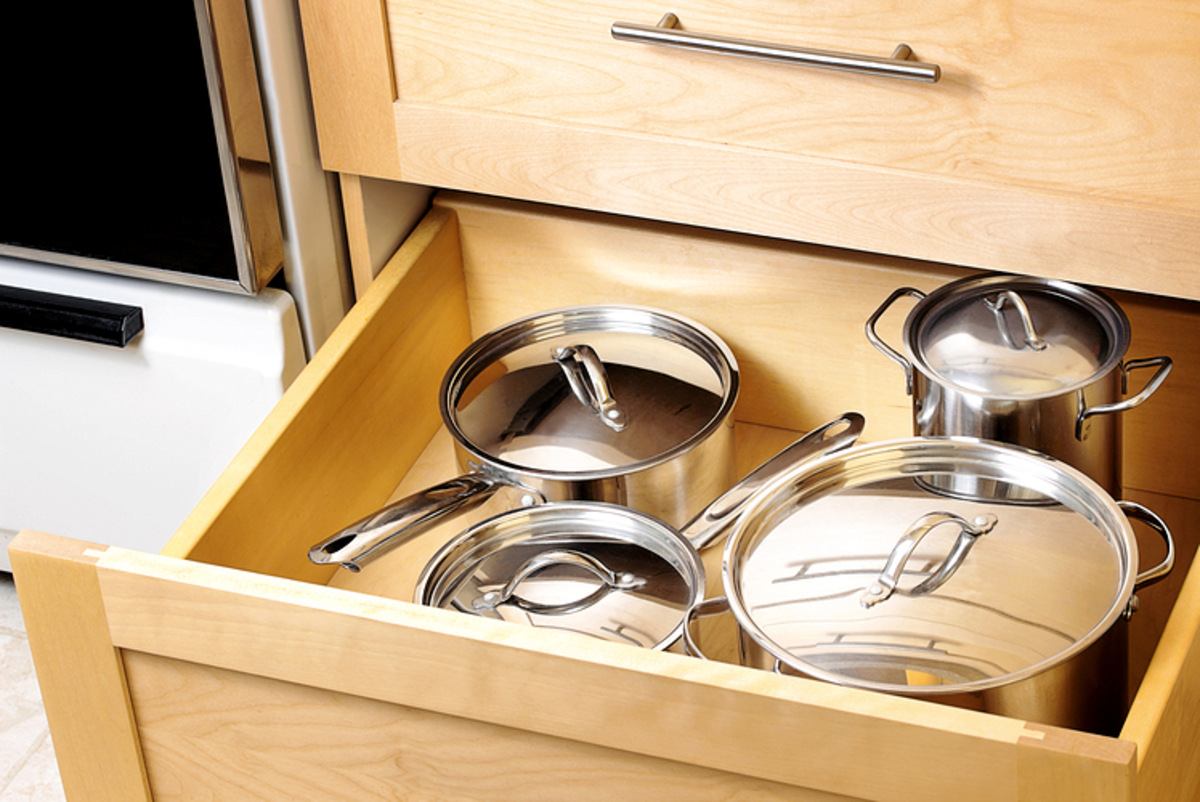Home>Storage Ideas>Kitchen Storage>Organizing A Refrigerator: 13 Safe Ways To Keep Food Fresh


Kitchen Storage
Organizing A Refrigerator: 13 Safe Ways To Keep Food Fresh
Modified: October 28, 2024
Discover 13 safe and effective kitchen storage ideas for organizing your refrigerator and keeping food fresh. Maximize space and maintain freshness with these practical tips.
(Many of the links in this article redirect to a specific reviewed product. Your purchase of these products through affiliate links helps to generate commission for Storables.com, at no extra cost. Learn more)
Introduction
Welcome to our comprehensive guide on organizing a refrigerator and keeping your food fresh. A well-organized refrigerator not only helps you find what you need easily but also plays a crucial role in preventing food waste and maintaining food safety. In this article, we will provide you with 13 safe and efficient ways to optimize your refrigerator storage and ensure that your food stays fresh for longer periods.
A refrigerator is a vital appliance in any kitchen, serving as a storage space for perishable items such as fruits, vegetables, meats, dairy products, and leftovers. However, without proper organization and temperature control, your refrigerator may become a breeding ground for bacteria and lead to food spoilage.
By implementing the tips and techniques we will discuss, you can not only extend the shelf life of your food but also create a functional and visually appealing refrigerator space. From setting the right temperature and separating raw and cooked foods to organizing specific food categories and regularly cleaning your refrigerator, we will cover all aspects of effective refrigerator organization.
Keeping your refrigerator well-organized is not just about convenience; it also helps you avoid cross-contamination, maintain food quality, and reduce the risk of foodborne illnesses. By following the guidelines outlined in this article, you can ensure that your refrigerator becomes a safe and efficient space for storing your perishable items.
Let’s dive into our 13 safe ways to keep your food fresh by optimizing your refrigerator storage.
Key Takeaways:
- Maximize food freshness and safety by setting the right refrigerator temperature, separating raw and cooked foods, and utilizing storage containers. Regular cleaning and monitoring food expiration dates are essential for a healthy and organized kitchen.
- Efficiently organize your refrigerator to reduce food waste, streamline meal preparation, and promote healthier eating habits. Utilize labeled storage containers, regularly clean your refrigerator, and stay vigilant about food expiration dates for a well-organized and safe kitchen.
Read more: How To Keep Celery Fresh In Refrigerator
Setting the Right Temperature – Keeping Your Refrigerator at the Optimal Temperature
One of the most important factors in maintaining food freshness and safety is setting the right temperature for your refrigerator. The optimal temperature range for most refrigerators is between 35°F to 38°F (1.7°C to 3.3°C). This temperature range helps slow the growth of bacteria while keeping your food sufficiently chilled.
Here are some tips to ensure that your refrigerator is set at the optimal temperature:
- Use an appliance thermometer: Place an appliance thermometer in the refrigerator section to monitor the temperature accurately. This will help you determine if any adjustments need to be made.
- Avoid extreme temperatures: Make sure your refrigerator is not set too warm or too cold. Extreme temperatures can accelerate food spoilage and impact the overall quality of your stored items.
- Adjust settings based on load: When you add a large amount of food to your refrigerator, such as after grocery shopping or a big meal, it’s advisable to lower the temperature slightly to compensate for the temporary increase in temperature. Once the food cools down, you can restore the normal temperature.
- Regularly check the temperature: Even if you have set the temperature correctly, it’s essential to regularly check the temperature to ensure it remains within the optimal range. This is especially crucial if you experience power outages or if your refrigerator is not of the highest quality.
Keeping your refrigerator at the right temperature is vital for food safety. Bacteria can multiply rapidly in warm temperatures, while extremely cold temperatures can freeze and damage food. By maintaining the correct temperature, you can safeguard your perishable items and extend their shelf life.
Additionally, it’s important to note that different areas of your refrigerator may have slightly different temperatures. The back of the refrigerator and the bottom shelves are typically colder, while the door shelves and top shelves are slightly warmer. Understanding these temperature variations can help you store items accordingly.
By following these temperature guidelines and ensuring that your refrigerator is set at the optimal temperature, you can effectively preserve the freshness of your food and minimize the risk of foodborne illnesses.
Separating Raw and Cooked Foods – Preventing Cross-Contamination
Preventing cross-contamination is crucial in maintaining food safety and preventing the spread of harmful bacteria. It is essential to separate raw and cooked foods in your refrigerator to avoid any potential contamination.
Here are some tips on how to properly separate raw and cooked foods:
- Use separate storage containers: Store raw meats, poultry, and seafood in sealed containers or plastic bags to prevent any juices from coming into contact with other foods. Likewise, keep cooked foods in separate containers and ensure they are tightly sealed.
- Use different shelves: Assign specific shelves to separate raw and cooked items. This helps prevent raw juices from dripping onto cooked or ready-to-eat foods, reducing the risk of foodborne illnesses.
- Place raw meats on the lowest shelf: The lower shelves of the refrigerator are typically colder, so it’s ideal to store raw meats on the lowest shelf to prevent any potential dripping onto other foods.
- Wrap and seal items properly: When storing raw meats, make sure they are well-wrapped to avoid any leakage. Double bagging or using leak-proof containers can provide an extra layer of protection.
- Label containers clearly: Properly labeling containers helps you distinguish between raw and cooked foods easily. Use clear labels to prevent any confusion or mishaps.
- Clean spills immediately: If any raw juices or liquids accidentally spill in your refrigerator, clean them up immediately with warm soapy water and disinfect the affected area to prevent the spread of bacteria.
Separating raw and cooked foods not only minimizes the risk of cross-contamination but also helps maintain the freshness and quality of your food. By following these practices, you can ensure that your refrigerator remains a safe environment for storing your perishable items.
Furthermore, be mindful of the positioning of different food items in your refrigerator. Store raw meats on the lowest shelves, away from any ready-to-eat foods, fruits, and vegetables. This prevents the transfer of bacteria from raw meats to other ingredients.
Remember, adopting these measures to separate raw and cooked foods is essential in preventing foodborne illnesses and maintaining the overall hygiene and safety of your refrigerator.
Utilizing the Door Shelves – Best Practices for Storing Items in the Door Shelves
The door shelves in your refrigerator are convenient spots for storing frequently used items such as condiments, sauces, and beverages. However, it’s important to understand the limitations of these shelves and follow best practices to ensure the proper storage of different items.
Here are some tips for effectively utilizing the door shelves:
- Keep stable and non-perishable items: The door shelves are subjected to temperature fluctuations due to frequent opening and closing of the refrigerator. It’s best to store items that are stable and non-perishable, such as condiments and sauces. These items can withstand the temperature changes without compromising their quality.
- Avoid storing dairy and eggs: Dairy products like milk and eggs should not be stored in the door shelves. The temperature in this area is typically warmer than in the main section of the refrigerator, which can lead to spoilage. It’s preferable to keep dairy products on the main shelves where it’s cooler.
- Store beverages safely: The door shelves are suitable for storing beverages like water bottles, soda cans, and juice cartons. Make sure to keep these items tightly secured to prevent spills that can contaminate other items in the refrigerator.
- Maintain proper weight distribution: Avoid overloading the door shelves with heavy items as it can affect the balance of the refrigerator door. Uneven weight distribution may cause the door to swing open or not seal properly, leading to temperature fluctuations and potential food spoilage.
- Be mindful of space limitations: Door shelves are typically narrower and less adjustable compared to the main shelves. Be mindful of the size and height of items you store in the door shelves to ensure they fit properly and don’t block the door from closing.
- Clean and organize regularly: Regularly clean the door shelves to remove any spills or sticky residue. This prevents the growth of bacteria and maintains a clean and hygienic environment in your refrigerator.
By following these best practices for utilizing the door shelves, you can make the most of this space and keep your frequently used items easily accessible. Remember to be mindful of the temperature limitations and choose the appropriate items to store in the door shelves to maintain food safety and quality.
Now that you have learned about utilizing the door shelves, let’s move on to organizing and properly storing different types of fruits and vegetables in your refrigerator.
Sorting Fruits and Vegetables – How to Store Different Types of Produce
Properly storing fruits and vegetables is key to preserving their freshness and maximizing their shelf life. Different types of produce have varying storage requirements, so it’s important to sort and store them appropriately in your refrigerator.
Here are some guidelines on how to store different types of fruits and vegetables:
- Leafy greens: Leafy greens such as lettuce, spinach, and kale should be stored in a plastic bag or airtight container to retain moisture. Placing a paper towel in the bag can help absorb excess moisture and prolong their freshness.
- Root vegetables: Root vegetables like carrots, beets, and radishes are best stored in perforated plastic bags to maintain proper airflow. This prevents moisture build-up and helps prevent spoilage. You can also remove the greens from root vegetables like carrots and store them separately.
- Tomatoes: Tomatoes should be stored at room temperature until they are fully ripe. Once ripe, store them in the refrigerator to slow down the ripening process and maintain their flavor and texture.
- Citrus fruits: Citrus fruits like oranges, lemons, and grapefruits can be stored at room temperature for up to a week. If you want to extend their shelf life, you can store them in the refrigerator in a ventilated bag.
- Berries: Berries like strawberries, blueberries, and raspberries are delicate and prone to spoilage. It’s best to store them in the refrigerator in their original packaging or in a shallow container lined with a paper towel to absorb excess moisture.
- Apples and pears: Apples and pears can be stored in the refrigerator to keep them fresh for a longer duration. However, they should be kept separate from other fruits and vegetables, as they emit a natural gas called ethylene that can cause other produce to ripen and spoil faster.
- Ethylene-sensitive produce: Certain fruits and vegetables, such as broccoli, cauliflower, and cucumbers, are sensitive to ethylene gas and should be stored away from ethylene-producing fruits like apples and bananas. This helps prevent premature ripening and spoilage.
- Herbs: Fresh herbs like cilantro, parsley, and basil can be stored in a glass of water, similar to a bouquet of flowers. Cover them loosely with a plastic bag and store them in the refrigerator. Alternatively, you can also wrap them in a damp paper towel and place them in a sealed bag.
Properly storing fruits and vegetables not only helps retain their freshness but also preserves their nutritional value. By following these storage guidelines, you can minimize food waste and ensure that your produce stays fresh and flavorful for as long as possible.
Now that you understand how to store different types of produce, let’s move on to an essential part of refrigerator organization – understanding the meat drawer and how to properly store meats to avoid spoilage.
Understanding the Meat Drawer – Properly Storing Meats to Avoid Spoilage
The meat drawer in your refrigerator is specifically designed to store raw meats and keep them at a consistent temperature, preventing cross-contamination and reducing the risk of spoilage. Understanding how to properly utilize the meat drawer can help you ensure the freshness and safety of your meats.
Here are some tips for effectively using the meat drawer:
- Keep meats wrapped: Store raw meats, such as poultry, beef, and pork, in their original packaging or wrap them tightly in plastic wrap or butcher paper. This prevents the spread of bacteria and helps maintain the quality of the meat.
- Separate meats: To prevent cross-contamination, it’s essential to separate different types of meats. Keep chicken, beef, and pork in separate containers or wrap them individually to avoid any potential contact between different meats.
- Utilize the humidity control: Some meat drawers have humidity control settings. For meats that require higher humidity, such as poultry, set the humidity control to a higher level. For other meats, keep the humidity control at a moderate level. This helps prevent the meat from drying out or becoming too moist.
- Label and date: It’s a good practice to label the meats stored in the meat drawer with the date of purchase to ensure you use them within the recommended timeframe. This helps you keep track of their freshness and avoid consuming expired or spoiled meat.
- Store deli meats separately: Deli meats should be stored separately from raw meats to prevent any potential contamination. Keep deli meats in a separate container or use a sealed plastic bag to maintain their freshness.
- Place a tray or liner: To catch any liquids that may drip from the meat packaging, place a tray or liner at the bottom of the drawer. This makes it easier to clean and prevents the spreading of potential bacteria.
Properly utilizing the meat drawer ensures that your raw meats are stored in a controlled environment, minimizing the risk of spoilage and extending their shelf life. Additionally, it helps maintain the safety of other fresh foods in your refrigerator by preventing cross-contamination.
Remember to check the meat drawer regularly for any signs of spoilage or expiration. If you notice any unpleasant odors, discoloration, or slimy textures, it’s best to discard the meat to avoid foodborne illnesses.
Now that you’ve learned about effectively using the meat drawer, let’s move on to the next topic – managing leftovers and prepared foods to ensure their safe storage in the refrigerator.
Managing Leftovers and Prepared Foods – Safely Storing Leftovers and Prepared Meals
Managing leftovers and prepared foods is an essential aspect of refrigerator organization. Storing them properly not only helps maintain their freshness but also ensures their safety for consumption.
Here are some tips for safely storing leftovers and prepared foods:
- Allow food to cool before storing: Before placing leftovers in the refrigerator, allow them to cool down to room temperature. Hot or warm food can raise the overall temperature inside the refrigerator and jeopardize the safety of other perishable items.
- Divide leftovers into smaller portions: If you have a large amount of leftovers, it’s advisable to divide them into smaller containers. This helps in faster cooling and efficient use of the refrigerator space. It also allows you to reheat only the portion you need, reducing waste.
- Use airtight containers: When storing leftovers, use airtight containers to prevent exposure to air and moisture. This helps retain the quality and flavor of the food and prevents any potential contamination.
- Label and date: It’s important to label the containers with the contents and date of storage. This helps you keep track of the freshness of the leftovers and ensures you consume them within a safe timeframe.
- Follow the “2-hour rule”: To minimize the risk of foodborne illnesses, refrigerate or freeze leftovers within two hours of cooking. Bacteria multiply rapidly at room temperature, so storing leftovers promptly helps prevent microbial growth.
- Store prepared meals properly: If you have store-bought or homemade prepared meals, follow the storage instructions provided. Some meals may need to be stored in the refrigerator, while others may require freezing. Be sure to follow the recommended guidelines for safe storage.
- Adhere to storage durations: Leftovers and prepared foods have specific storage durations. It’s important to be aware of how long they can be safely stored in the refrigerator or freezer. Consuming expired leftovers can increase the risk of foodborne illnesses.
- Reheat leftovers properly: When reheating leftovers, ensure they are heated to a safe internal temperature to kill any potential bacteria. Use a food thermometer to check the temperature, and make sure the food is hot all the way through before consuming.
By following these guidelines, you can safely store and enjoy leftovers and prepared foods without compromising their quality or risking foodborne illnesses. It’s crucial to stay vigilant and regularly check for any signs of spoilage or expiration dates to ensure the safety of your stored foods.
Now that you’ve learned how to manage leftovers and prepared foods, let’s move on to the next topic – arranging dairy products to maximize their freshness and flavor in the refrigerator.
Arranging Dairy Products – Tips for Storing Milk, Cheese, and Other Dairy Items
Properly storing dairy products is essential to maintain their freshness, flavor, and quality. Whether it’s milk, cheese, or other dairy items, following these tips will help you arrange and store them effectively in your refrigerator.
Here are some guidelines for storing different dairy products:
- Milk: Milk should be stored on the main shelves rather than the door shelves. The temperature on the door shelves fluctuates more frequently due to frequent opening and closing of the refrigerator, which can affect the milk’s freshness. Keep the milk away from strong-smelling foods to prevent it from absorbing any unwanted odors.
- Cheese: Cheese should be stored tightly wrapped in wax or parchment paper. Avoid using plastic wrap as it can trap moisture and promote mold growth. For soft cheeses like mozzarella or feta, store them in their original packaging or in a container filled with brine. Harder cheeses, such as cheddar or Swiss, can be stored in a separate drawer or wrapped tightly in cheese paper to maintain freshness.
- Butter: Butter can be stored in the refrigerator, but if you use it frequently, leaving a portion at room temperature in a covered dish is acceptable. This allows it to soften for easy spreading. To prevent it from absorbing odors, store butter in an airtight container or a butter dish with a lid.
- Yogurt: Yogurt cups should be stored on the refrigerator shelves, preferably towards the back where it’s cooler. Avoid placing them in the door shelves, as the temperature can vary more there. If you have a large container of yogurt, transfer a portion into a smaller container for easier access and to avoid exposing the entire container to air each time you open it.
- Sour cream and cream cheese: Sour cream and cream cheese should be sealed tightly and stored on the refrigerator shelves. Like yogurt, they can spoil if left in the door shelves due to frequent temperature changes. Be sure to check the expiration dates regularly and discard any expired products.
- Whipped cream: Store whipped cream in its original container in the refrigerator. If it doesn’t come in a sealed container, transfer it to an airtight container to prevent it from absorbing odors and losing its texture.
- Other dairy items: Other dairy items like cottage cheese, ricotta, and kefir should be stored according to their specific instructions. Check the packaging for guidelines on storage temperature and duration. It’s best to keep them tightly sealed and stored on the main shelves of the refrigerator.
By following these storage tips, you can ensure that your dairy products stay fresh and delicious for longer. Remember to regularly check the expiration dates and discard any dairy items that show signs of spoilage or unusual odor.
Now that you know how to arrange and store dairy products effectively, let’s move on to the next topic – organizing condiments and sauces to maximize their shelf life in the refrigerator.
Store raw meat on the bottom shelf to prevent any potential drips or leaks from contaminating other foods. Keep it in a sealed container or on a plate to catch any juices.
Organizing Condiments and Sauces – Ensuring the Longevity of Condiments and Sauces
Condiments and sauces are pantry staples that can add flavor and enhance the taste of your meals. Properly organizing and storing these items in the refrigerator is essential to ensure their longevity and maintain their quality.
Here are some tips for organizing condiments and sauces in your refrigerator:
- Check expiration dates: Before organizing your condiments and sauces, check the expiration dates. Discard any items that are past their expiration dates to avoid consuming expired products.
- Categorize similar items: Group condiments and sauces together based on their category. Place similar items such as ketchup, mustard, and mayonnaise in the same section or drawer. This way, you can easily find what you need when cooking or making sandwiches.
- Arrange by frequency of use: Organize your condiments and sauces based on the frequency of use. Keep the ones you use more frequently in an easily accessible area, while those used less often can be placed towards the back or on the higher shelves.
- Store upright and sealed tight: Make sure to store condiment bottles and jars upright to prevent leakage. Check the caps and lids to ensure they are tightly closed to maintain freshness and prevent any cross-contamination.
- Utilize the door shelves: The door shelves are ideal for storing condiments and sauces due to their convenience and easy access. However, be mindful of the temperature fluctuations on the door and avoid storing highly perishable items there.
- Label homemade or decanted condiments: If you have homemade or decanted condiments, label them clearly with the contents and the date they were prepared or transferred. This helps you keep track of their freshness and ensures you use them within a reasonable timeframe.
- Refrigerate after opening: Most condiments and sauces need to be refrigerated after opening, even if the label doesn’t specify. This prevents the growth of bacteria and helps maintain their flavor and texture. Be sure to follow the specific instructions on the label.
- Check for signs of spoilage: Regularly inspect the condiments and sauces for any signs of spoilage, such as mold growth, unusual color changes, or off-putting odor. If you notice any of these signs, it’s best to discard the item.
By following these tips, you can ensure that your condiments and sauces stay fresh and flavorful for a longer period. Regularly organizing and checking the condition of condiments and sauces will help you maintain an organized and well-stocked refrigerator.
Now that you’re familiar with organizing condiments and sauces, let’s move on to the next topic – best practices for storing eggs in the refrigerator.
Storing Eggs Safely – Best Practices for Storing Eggs in the Refrigerator
Eggs are a versatile and nutritious staple in most kitchens. Properly storing eggs in the refrigerator is crucial to maintain their freshness, quality, and safety. Follow these best practices to ensure your eggs are stored safely.
Here are some guidelines for storing eggs in the refrigerator:
- Keep eggs in their original carton: Eggs are best stored in their original carton, as it provides protection and helps maintain their integrity. The carton also contains important information, such as the expiration date and lot number, which can be helpful for tracking their freshness.
- Store eggs in the main body of the refrigerator: The main body of the refrigerator offers a stable temperature, which is ideal for storing eggs. Avoid placing them in the refrigerator door, as this area is subjected to temperature fluctuations due to opening and closing the door frequently.
- Avoid washing eggs before storage: Eggs have a natural protective coating called the cuticle, which helps prevent bacteria from entering the shell. Washing eggs can remove this protective layer, making them more susceptible to contamination. It’s best to only wash eggs just before using them.
- Store eggs in a dedicated area: Designate a specific area in the refrigerator to store eggs. This makes it easier to keep an eye on their freshness and prevents them from being accidentally knocked over or damaged by other items.
- Keep eggs away from strong-smelling foods: Eggs are porous and can absorb odors from strong-smelling foods. Store them away from items like onions, garlic, or strong cheeses to prevent them from acquiring unwanted flavors.
- Check for freshness: Before using an egg, always check its freshness. You can perform a simple freshness test by placing the egg in a bowl of water. Fresh eggs sink to the bottom, while older eggs float or stand upright due to air pockets that develop over time.
- Dispose of cracked or damaged eggs: Cracked or damaged eggs should not be stored. Use them immediately or dispose of them properly to avoid any risk of contamination.
- Handle with care: When handling eggs, be gentle to avoid any cracks or damage to the shells. Place them in the carton carefully to prevent breakage.
- Use refrigerated eggs promptly: Eggs stored in the refrigerator should be used within a reasonable timeframe. While the USDA recommends using eggs within three to five weeks of the pack date, it’s best to adhere to the expiration date on the carton for optimal freshness and safety.
By adhering to these best practices, you can ensure that your eggs stay fresh, safe, and ready for use in your favorite recipes. Remember to check for any signs of spoilage or expiration dates before consuming eggs.
Now that you know how to store eggs safely, let’s move on to discussing the proper storage of deli meats and sandwich fillings in the refrigerator.
Preserving Deli Meats and Sandwich Fillings – Keeping Deli Meats and Sandwich Fillings Fresh
Preserving the freshness of deli meats and sandwich fillings is essential to ensure their taste, texture, and safety. Whether you’re planning to make a delicious sandwich or use deli meats in your favorite recipes, following proper storage practices is key.
Here are some tips for keeping deli meats and sandwich fillings fresh in the refrigerator:
- Unopened deli meats: If you have unopened deli meats, store them in their original packaging in the refrigerator. Keep them in the meat drawer or on a designated shelf to maintain a consistent and cool temperature.
- Opened deli meats: Once you open a package of deli meats, it’s important to reseal them tightly to prevent moisture loss and exposure to air. You can use food-safe wrapping or transfer them to airtight containers for better preservation.
- Sandwich fillings: For prepared or homemade sandwich fillings like egg salad, tuna salad, or chicken salad, store them in airtight containers in the refrigerator. These fillings should be used within a few days to maintain their freshness. Ensure that the containers are labeled with the contents and date of preparation.
- Separate different meats: It’s crucial to separate different types of deli meats to prevent cross-contamination. Store each type of meat separately, or use individual compartments in your refrigerator to prevent their juices from mingling and compromising the quality.
- Properly wrap deli meats: If you prefer to get deli meats sliced at the counter, ask for them to be wrapped in separate sheets of deli paper or place them in individual resealable bags. This ensures that the meats are protected and stay fresh for a longer period.
- Rotate the deli meats: When storing deli meats, it’s a good practice to use the “first in, first out” method. Arrange the deli meats in the refrigerator so that the oldest ones are easily accessible and consumed first.
- Maintain the correct refrigerator temperature: It’s vital to keep the refrigerator temperature set between 35°F to 38°F (1.7°C to 3.3°C) to ensure the freshness and safety of deli meats. This temperature range slows down bacterial growth and helps preserve the quality of the meats.
- Regularly check for spoilage: Frequently inspect deli meats for any signs of spoilage, such as an off smell, sliminess, or discoloration. If you notice any of these signs, it’s best to discard the deli meat to ensure food safety.
- Keep an eye on expiration dates: Pay attention to the expiration dates on deli meat packaging. Consume the meats before the expiration date to enjoy them at their best quality.
By following these guidelines, you can ensure that your deli meats and sandwich fillings stay fresh and maintain their flavor. Proper storage not only extends their shelf life but also plays a crucial role in preventing foodborne illnesses.
Now that you know how to preserve deli meats and sandwich fillings, let’s move on to discuss efficient organization techniques for the freezer compartment of your refrigerator.
Maintaining the Freezer Compartment – Tips for Efficiently Organizing Frozen Foods
Efficiently organizing the freezer compartment of your refrigerator is essential for maximizing storage space and ensuring the longevity of frozen foods. With proper organization, you can easily locate items, avoid freezer burn, and prevent food waste. Here are some tips to help you maintain an organized and efficient freezer:
- Categorize frozen foods: Sort frozen foods into categories such as meats, vegetables, fruits, and prepared meals. This makes it easier to find specific items when needed.
- Use freezer-safe containers: To prevent freezer burn and maintain the quality of frozen foods, store them in freezer-safe containers or bags. Make sure to remove as much air as possible before sealing to minimize freezer burn.
- Label and date items: Label all containers or bags with the contents and date of freezing. This helps you keep track of how long items have been stored and prevents confusion when looking for specific items.
- Utilize storage bins or dividers: Consider using storage bins or dividers to organize smaller items like frozen vegetables or individual servings. These containers help keep items grouped together and make it easier to access and rotate out older ones.
- Arrange items by accessibility: Place frequently used items within easy reach. Keep them towards the front of the freezer to ensure quick and convenient access.
- Utilize vertical space: Take advantage of vertical space by using stackable containers or freezer-safe bins. This allows you to make the most of the available space and keeps items organized.
- Follow the “first in, first out” rule: When adding new items to the freezer, be sure to move older items forward. This ensures that older items are used first, reducing the chances of food going to waste.
- Regularly declutter and organize: Schedule regular decluttering sessions to remove any expired or freezer-burned items. Take the time to reorganize and rearrange items as needed to maintain an efficient and tidy freezer compartment.
- Keep a list or inventory: Consider keeping a list or inventory of the items in your freezer. This can help you keep track of what you have and avoid purchasing duplicates. You can also use this list to plan meals and reduce food waste.
- Be mindful of the temperature: Ensure that the freezer maintains a temperature of 0°F (-18°C) or below. This ensures that frozen foods stay properly preserved and safe to consume.
By implementing these tips, you can maintain an organized freezer compartment and make the most of the available space. An efficiently organized freezer not only saves time and reduces food waste but also helps preserve the quality and flavor of frozen items.
Now that you’ve learned how to efficiently organize the freezer, let’s move on to the importance of using storage containers and labels for effective kitchen organization.
Using Storage Containers and Labels – The Benefits of Properly Labeled Storage Containers
Using storage containers and labels is an essential aspect of effective kitchen organization, including the organization of your refrigerator and pantry. Properly labeled storage containers offer numerous benefits, from maintaining food freshness to streamlining meal preparation. Here are some key advantages of using labeled storage containers:
- Preserving food freshness: Using airtight storage containers helps prevent air exposure, which can lead to food spoilage. By sealing your perishable items in containers, you can extend their shelf life and maintain their freshness.
- Preventing cross-contamination: Labeled containers allow you to separate different food items and prevent cross-contamination. For example, you can store raw meats, cooked foods, and ready-to-eat items in separate containers to ensure food safety and minimize the risk of bacterial growth.
- Maximizing storage space: Storage containers come in various shapes and sizes, allowing you to optimize the use of available space in your refrigerator, pantry, or cabinets. By using uniformly sized containers, you can stack them neatly, making the most of your kitchen storage areas.
- Simplifying meal planning and preparation: Labeled containers make it easy to identify specific ingredients or prepared meals, saving time and effort when planning and preparing meals. You can quickly locate the items you need, reducing meal prep time and minimizing food waste.
- Improving visibility and accessibility: Clear storage containers with labels allow you to see the contents at a glance. This improves visibility, making it easier to find and retrieve specific items without having to rummage through the refrigerator or pantry shelves.
- Reducing food waste: Properly labeled containers help you keep track of expiration dates and the freshness of stored foods. By clearly indicating the date of storage or preparation, you can easily identify when items need to be consumed and minimize food waste.
- Enhancing organization and cleanliness: Labeled storage containers contribute to a well-organized and clutter-free kitchen. By neatly storing items and keeping shelves and surfaces clean, you create a visually appealing and functional space that makes cooking and mealtime more efficient.
- Facilitating portion control: Portioning meals into labeled containers can support portion control and help you maintain a balanced diet. By pre-portioning meals or snacks, you have better control over portion sizes and can easily grab a ready-to-eat, well-portioned option.
- Encouraging healthy eating habits: Having labeled storage containers filled with nutritious foods, such as fruits, vegetables, and homemade snacks, can encourage healthier eating habits. They serve as a visual reminder and make it convenient to choose healthier options instead of reaching for processed or unhealthy foods.
By utilizing storage containers and labeling them appropriately, you can reap numerous benefits that simplify kitchen organization, support food freshness, reduce waste, and enhance your overall cooking experience. Take the time to label your containers accurately, and enjoy the advantages of an efficiently organized kitchen.
Now that you understand the benefits of using storage containers and labels, let’s move on to the importance of regularly cleaning your refrigerator and checking food expiration dates.
Regularly Cleaning and Checking Expiry Dates – Importance of Cleaning and Monitoring Food Expiration Dates
Regularly cleaning your refrigerator and monitoring food expiration dates are crucial practices for maintaining a safe and organized kitchen. By prioritizing cleanliness and staying vigilant about expiration dates, you can ensure the freshness, quality, and safety of your stored food. Here’s why these tasks are vital:
- Preventing bacteria growth: Cleaning your refrigerator regularly helps eliminate spills, leaks, and food residue that can harbor harmful bacteria. The warm and moist environment of the refrigerator can contribute to the growth of bacteria, so thorough cleaning minimizes the risk of cross-contamination and foodborne illnesses.
- Eliminating odors: Over time, food odors can accumulate in the refrigerator, affecting the taste and aroma of fresh foods. Regular cleaning helps eliminate these odors, creating a pleasant and inviting environment in your kitchen.
- Keeping surfaces free from mold and mildew: Mold and mildew can develop in humid environments, such as the corners or gaskets of your refrigerator. Regular cleaning helps remove any mold or mildew growth, ensuring a hygienic and safe space for your food.
- Minimizing the risk of foodborne illness: Cleaning your refrigerator reduces the chance of cross-contamination between different food items. By wiping down surfaces, shelves, and drawers, you eliminate potential sources of contamination, making your stored food safer to consume.
- Optimizing food organization: Regular cleaning provides an opportunity to reorganize the contents of your refrigerator. By removing expired or spoiled items, you make room for fresh ingredients and better visibility of what you have. This allows for efficient meal planning and grocery shopping.
- Checking food expiration dates: Monitoring and respecting food expiration dates is crucial for food safety. Regularly checking dates helps you identify items that need to be consumed soon or discarded. Consuming expired foods can lead to food poisoning and other health risks.
- Reducing food waste: Being aware of expiration dates allows you to avoid unnecessary food waste. By keeping track of what needs to be used in a timely manner, you can plan meals accordingly and reduce the likelihood of throwing away perfectly good food.
- Maintaining food quality: Consuming foods past their expiration dates may result in a decline in taste, texture, and nutritional value. By monitoring expiration dates, you ensure that you’re using ingredients at their peak quality, resulting in more enjoyable meals and a better overall culinary experience.
- Promoting efficient meal planning: By regularly checking expiration dates, you can identify items that are near their expiration and incorporate them into meal planning. This not only reduces potential food waste but also encourages creativity in the kitchen by utilizing ingredients before they spoil.
Establishing a routine for cleaning your refrigerator and regularly checking food expiration dates is essential for maintaining a safe and organized kitchen. These practices promote food safety, minimize waste, and contribute to a healthier and more efficient cooking environment.
Remember, cleanliness and vigilance when it comes to food expiration dates are key to ensuring the quality and safety of the food you and your family consume.
With this, we conclude our guide on organizing a refrigerator and keeping your food fresh. By implementing the tips and practices discussed in each section, you can create an organized and efficient refrigerator space that maximizes food freshness, minimizes waste, and promotes a healthier lifestyle. Happy organizing!
Conclusion
Organizing your refrigerator and effectively storing your food is not just about maintaining a tidy space – it’s about ensuring the freshness, quality, and safety of your food. By following the tips and best practices outlined in this guide, you can create a well-organized refrigerator that maximizes the shelf life of your perishable items, reduces food waste, and promotes a healthier kitchen environment.
From setting the right temperature and separating raw and cooked foods to properly storing fruits, vegetables, dairy products, and condiments, each aspect of refrigerator organization plays a crucial role in maintaining food freshness. Additionally, managing leftovers, preserving deli meats, and efficiently organizing the freezer all contribute to a more convenient and streamlined cooking experience.
Regularly cleaning your refrigerator and diligently checking food expiration dates are equally important. These practices ensure a clean and hygienic storage environment, reducing the risk of bacterial growth and cross-contamination. Keeping track of expiration dates helps you use your ingredients before they spoil, minimizing food waste and optimizing meal planning.
By implementing these strategies, you create a kitchen space that is not only functional and visually appealing but also supportive of healthier eating habits. You’ll be able to easily access your ingredients, make informed decisions about what to consume, and enjoy fresh and flavorful meals.
Remember, an organized refrigerator is an investment in the longevity and quality of your food. Take the time to arrange your items purposefully, label your storage containers, and stay vigilant with cleanliness and expiration dates. By doing so, you’ll create a kitchen that brings joy, efficiency, and, most importantly, safe food to your table.
So, get ready to transform your refrigerator into a well-organized haven for freshness and deliciousness. Happy organizing and enjoy the benefits of a thoughtfully arranged kitchen!
Frequently Asked Questions about Organizing A Refrigerator: 13 Safe Ways To Keep Food Fresh
Was this page helpful?
At Storables.com, we guarantee accurate and reliable information. Our content, validated by Expert Board Contributors, is crafted following stringent Editorial Policies. We're committed to providing you with well-researched, expert-backed insights for all your informational needs.













0 thoughts on “Organizing A Refrigerator: 13 Safe Ways To Keep Food Fresh”